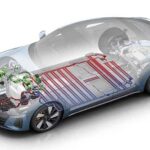Electric vehicles are getting immense recognition, and these will be the primary force behind future mobility. Now that everyone is fully aware of this truth, let’s explore what an EV’s heart is actually like. Although they are out of sight, batteries are one of the biggest and most significant parts of any electric vehicle. A battery is a device that uses an electrochemical reaction to transform chemical energy to electric energy. In an electronic circuit, an electrochemical reaction happens when electrons move from a particular material to another.
Explore the Different Types
Which battery kinds are found in EVs? Electricity stored in batteries is used to power electric vehicles. There are numerous varieties of batteries on the market. Lithium-Ion batteries, solid-state batteries, lead-acid batteries, nickel-metal hydride batteries, and ultra-capacitors are a few of them. Lithium-ion batteries, however, are the most effective and favoured type.
Working of EV Batteries and the Battery Chemistry
To generate power, a conventional battery needs three components: Anode is the battery’s negative side, whereas cathode is its positive side. Electrolyte is a chemical paste that converts chemical energy to electrical energy by separating the anode and cathode. A mixture of components including zinc (the anode), manganese (the cathode), and potassium make up 60% of the battery. An electrode simply put is a material used for electrical conduction inside of a battery. Similar to an electrolytic cell, the electric current enters or exits the non-metallic medium. An electrode, to put it simply, is a conductor that aids in making electrical contact with the non-metallic component of the circuit.
Cathode and anode, which essentially specify the direction of current flow, are the two primary components of an electrode. The positive serves as a cathode and the negative as an anode during discharge. Positive serves as an anode during charging, whereas negative serves as a cathode. In a Li-ion battery, lithium ions travel from negative electrode to positive electrode via an electrolyte during discharge and back again during charging. Li-ion batteries commonly use graphite for the negative electrode and intercalated lithium compound for the positive electrode.
Environmental Impact of EV Battery
We are all accountable for implementing eco-friendly improvements where we can since greenhouse gases like carbon dioxide, methane, and nitrous oxide alter the atmosphere and make the earth vulnerable to climate change. Electric vehicles could be a part of the solution because cars account for 72% of the emissions emitted in the transportation industry, a large proportion to carbon released into the environment.
Lithium-ion batteries power electric vehicles. Lithium mining and battery production need a lot of water, which pollutes the air, soil, and water. However, when evaluating the entirety of their life cycles, electric vehicles are “greener” overall than gasoline-powered vehicles (including battery production and disposal). Batteries for electric cars thereby lessen our overall environmental effect. Consider the following: even if battery manufacture and disposal is environmentally damaging, electric vehicle powering is better for the environment than gasoline-powered vehicle powering. Naturally, this does not imply that the environmental impact of EV batteries is zero.
Benefits Galore
As an alternative to the conventional car battery, electric car batteries provide an automobile with power. The battery in battery EVs, or BEVs, can be used to store electricity that can later be utilized to power the motor, which rotates the wheels and propels the vehicle. Since an EV battery performs the same function as a gas or diesel engine when the vehicle is in motion, this approach is thought to be an effective substitute for these fuels. These batteries often have a larger size than typical automotive batteries, which allows them to store more energy. Over conventional car batteries, electric car batteries provide a number of glaring advantages.
They do not utilize gas, to start. Owners of electric vehicles are thought to be able to save over $1,500 on gas per year. Additionally, electric vehicles are extremely effective at storing and maintaining their energy while they are in motion. In order to conserve electricity, the battery will turn off when the car is stopped, and while the brakes are applied, the battery actually will recharge. The term for this is regenerative braking. Last but not least, the typical driving range of BEVs nowadays is between 80 and 100 miles, which is above sufficient for the majority of drivers’ everyday use. However, automakers are working to create batteries that can propel vehicles up to 265 miles without running out of juice, or at least 200 miles on one charge.
4 Simple Tips to Extend EV Battery Longevity
- Minimum exposure to very high temperature while being parked
- Minimize the battery to 100 percent state of charge
- Avoid fast charging
- Control the optimal state of charge of the battery during long storage
EV Battery- The Future
The next big thing might be solid state electric vehicle batteries. In solid state EV batteries, the liquid-based electrolyte is swapped out for a solid electrolyte by a chemical mechanism that is extremely reminiscent of lithium-ion technology. In comparison to traditional lithium-ion batteries, solid state EV batteries can be smaller and lighter. These advantages aid in lowering battery weight and increasing energy density. Solid state batteries must be able to charge more quickly and have a longer lifespan. Safety has also increased. They could be still five years away from production, though, because manufacturing them is still technically challenging and much of the necessary technology is still being explored.
In the meanwhile, thanks to new lithium-iron phosphate technology, electric car maximum ranges will increase to 500 miles & beyond while costs of battery will decrease. The number of EVs that can use ultra-rapid chargers will grow, and so will the rate of charging.
Source: Market Research Future Report




